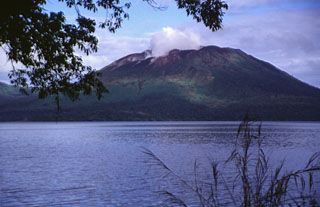Report on Gaua (Vanuatu) — 14 April-20 April 2010
Smithsonian Institution / US Geological Survey
Weekly Volcanic Activity Report, 14 April-20 April 2010
Managing Editor: Sally Sennert.
Please cite this report as:
Global Volcanism Program, 2010. Report on Gaua (Vanuatu) (Sennert, S, ed.). Weekly Volcanic Activity Report, 14 April-20 April 2010. Smithsonian Institution and US Geological Survey.
Gaua
Vanuatu
14.281°S, 167.514°E; summit elev. 729 m
All times are local (unless otherwise noted)
Based on analysis of MODIS satellite imagery and information from the Vanuatu Geohazards Observatory, the Wellington VAAC reported ash plumes from Gaua during 13-16 and 19-21 April. The plumes regularly rose to altitudes of 3 km (10,000 ft) a.s.l. The advisories on 14-15 April noted that the plumes were mostly steam. A spokesman for the Vanuatu Disaster Management Office described the activity as "huge, dark plumes" in an AAP news report.
Geological Summary. The roughly 20-km-diameter Gaua Island, also known as Santa Maria, consists of a basaltic-to-andesitic stratovolcano with an 6 x 9 km summit caldera. Small vents near the caldera rim fed Pleistocene lava flows that reached the coast on several sides of the island; littoral cones were formed where these lava flows reached the ocean. Quiet collapse that formed the roughly 700-m-deep caldera was followed by extensive ash eruptions. The active Mount Garet (or Garat) cone in the SW part of the caldera has three pit craters across the summit area. Construction of Garet and other small cinder cones has left a crescent-shaped lake. The onset of eruptive activity from a vent high on the SE flank in 1962 ended a long period of dormancy.
Sources: Vanuatu Meteorology and Geohazards Department (VMGD), Wellington Volcanic Ash Advisory Center (VAAC), Australian Associated Press

